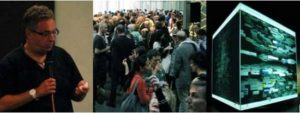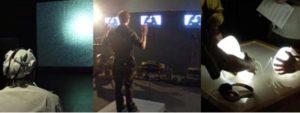



ISEA2008 quick facts: held in Singapore, 25 July – 3 August 2008. ISEA has been running for two decades. It began in 1988 as the Inter-Society for Electronic Arts. It is now the International Symposium on Electronic Art. It has been a biennial event, but from next year becomes annual. A new ISEA Foundation has been developed. The coordinating role passes from Nina Czegledy to Julianne Pierce. The 2009 event will be held in Dublin (first call for papers coming this September). ISEA2010 is likely to be in Germany (Ruhr region).

In his weirdly scheduled ISEA2008 lecture – delivered the day after the closing night party – Lev Manovich argued that we have shifted from a state of new media to one of ‘more’ media. There is simply so much media these days (the product of new technologies and social interactive forms) that it is humanly impossible to gain an overall perspective. Our only viable option is to draw upon the quantitative methods that have driven contemporary science and business. We must data-mine culture in order to develop new methods of visualisation that have the potential to represent cultural patterns indiscernible to the naked critical eye and provide a necessary interface to the universe of specific cultural objects. Manovich dubs this new critical and expressive field, ‘cultural analytics’. While I am suspicious that significant aspects of culture are so easily amenable to discrete quantitative representation, Manovich’s lecture, delivered to a packed audience, resonated very much with my experience of ISEA2008. With its 800 delegates, five concurrent streams, juried exhibition and huge range of associated panels, seminars, workshops and exhibitions, ISEA2008 was anything but digestible. As Andreas Broeckmann suggested at the ISEA board meeting, every participant is likely to have had a substantially different experience of the event depending upon their particular path through it. A stronger and more clearly integrated keynote program may have helped, but there are clear issues of scale that no manner of organization can solve. Lacking the means to effectively data-mine the event, all I can offer here is a sample of issues that emerged for me.
Rendering Vectors
I was initially a bit disappointed when I wandered down into the bowels of the National Museum of Singapore to see the juried exhibition. Very little stood out and many works seemed either poorly resolved or overblown. Alternative browsers have been a staple of net-art since the late 90s, so it felt odd to encounter a huge 3D triangle displaying images from yet another alternative browser (Metahaven’s Exodus). Similarly, Horia Cosmin Samoila and Marie Christine Driesen’s representation of alpha brain activity in terms of a swirling sphere of white points against a black background, Untitled, seemed little more than a dubious science show exhibit, indulging in standard tropes of mind as a flowing galaxy-style space (much better if they had reduced the visualization to a 32X32 grid of pixels). More conceptually interesting was Shilpa Phadke, Shilpa Ranade and Sameera Khan’s Gendered Strategies for Loitering which aimed to represent gender-based differences in urban spatial experience. Women, it seems, can move safely through public spaces in Mumbai and Singapore but they cannot loiter. Unfortunately the work itself did not really make this point sufficiently clear. It combined a multi-screen video projection with a computer game simulation when, more likely, a reduction of technological means was necessary. Linking these three works is a fundamental concern with developing new means of rendering elusive processes – whether related to data flows, physical processes or social interaction. They, and many other works in the juried show and associated exhibitions, aim less to depict stable things than to portray vectors, trajectories and movements. Despite their limitations (a bit lessened upon learning that the juried show was developed during a very short lead-up ISEA residency program), these works represent an interesting effort to render aspects of mobility (within larger spaces that are themselves conceived in mobile terms).

Positioning Play
Play is a central conceit within contemporary electronic art, but how is it articulated? How does it take shape? More particularly, how does it engage with popular forms of computer-mediated play and with what the French art theorist, Nicolas Bourriaud, has termed the ‘relational’ play of contemporary art? This is a question that Australian academic, Daniel Palmer, posed in his excellent paper, “The Critical Ambivalence of Play in Media Art”. Media/electronic art, Palmer suggests, is awkwardly positioned between popular entertainment (Wii consoles and the like) and the modeling of social relations in radical art; never quite satisfying either camp – never permitting play a simple (uncritical) precedence or, on the other hand, a properly dialogic aesthetic shape. One response to this dilemma is the pursuit of ever richer and more kinaesthetically engaging interfaces. Arguably, however, it is not by effacing the technological character of interaction – by returning it to some unconvincing phenomenological state – that the fundamental issues of play are delineated and addressed. Instead it is by exploring the irregular contours of interaction – its blind spots, interstices and spaces of contradiction – that other dimensions of play become evident. The play, for example, of Tad Ermitano’s Quartet (juried show) relates ostensibly to the sense of controlling a traditional gamelan orchestra via hand gestures. The actual play, however, relates to the strange, clumsy, obviously wired and mediated character of the interaction – the sense of indirection, of curious mechanical autonomy. Similarly, Priscilla Bracks, Gavin Sade and Matt Dwyer’s Charmed (associated exhibition, Experimenta Play++) is as much about the artificiality of computer mediated spatial interaction (and worlds) as it is an appealing navigable environment. The play lies in its subversion of ordinary interface expectations – its insistence, for instance, that physically shifting a viewing pod about on a table alters the view on the world (contrary to the typical expectation that a screen serves as a stable container for an internal universe). These works have a dimension of play that runs alongside and counter to their obvious playfulness. This dimension is less about manipulation and immediate feedback than about the playful disturbance of conventional interactive paradigms.
Managing ‘More’ Media
The German media arts historian, Oliver Grau, spoke about the need to develop a large archival project that would map and conserve the heritage of media arts practice. He argued that there have been a number of efforts to develop such a resource, but that they have all foundered under the weight of technological and financial demands. He provided an overview of a new on-line archive, The Database of Virtual Art, which has been developed at Danube University Krems and has an impressive advisory panel drawn from around the world. While developing effective and sustainable means for managing the heritage of media arts is clearly a worthwhile objective, I am uncomfortable with the thought of a centralised database project – particularly if alongside conservation the archive also aims to assume an editorial/curatorial role, tracing out main threads of development and a canon of key works. There is a risk, despite the advisory panel, that the archive will ignore, or treat as secondary, all manner of local contexts and practices that may or may not be in step with whatever dominant (probably North American and European) paradigm of development is identified. It may better to facilitate the creation of a range of local (distributed) archives. In my view, any universal system should have the more restricted role of enabling communication between the archival nodes, rather than serving as an uber-perspective on the field.
Despite my reservations, I found ISEA2008 an interesting and useful event, if only to confront all sorts of views and practices alien to my own and to have the opportunity to speak to a variety of artists and theorists directly. No possibility of adequately taking in the whole event, but is that really so essential? Is a map of everything better than a set of specific, limited encounters? Actually, if I wanted to say anything more, it would be to mention further specific details: Alex Monteith’s wonderfully playful (but non-interactive) video installation, Composition for Farmer, in the associated NZ exhibition, Cloudland; Paul Brown’s insightful effort to trace the roots of the split between contemporary art and media/electronic arts to a division between sensualism and intellectualism within modernism; and Daniel Peltz’s, Beepez-le, a small poetic piece reflecting upon mobile phone practices in Cameroon. Which leaves me with one last question, how am I going to get to Dublin?